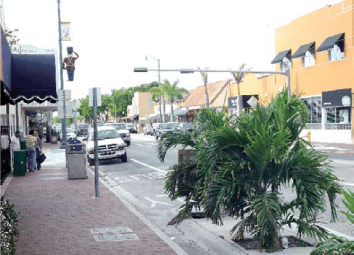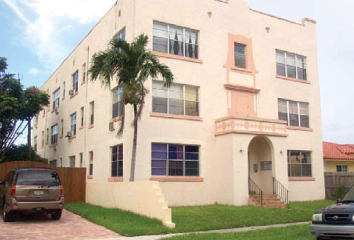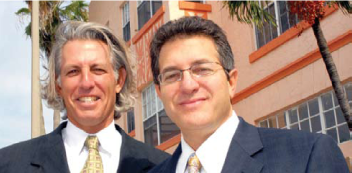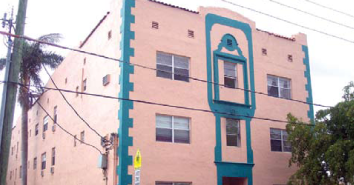Making it big in little Havana
Aaron and Daniel Stauber have a unique ability to rediscover and transform city districts long forgotten or discarded by others. Their latest transformation is Miami’s Little Havana area. While other major builders are shifting out of affordable housing projects, the Stauber brothers have moved in – in a big way. Through the development of 22 properties they are providing the lowincome area with much needed Section-8 and workforce housing.
The Stauber brothers have a long history in real estate development. Aaron Stauber is the President of Rugby Realty Co., Inc., a New York company formed in 1980, which specializes in the redevelopment of abandoned buildings. Rugby has been guided by their investment philosophy “to develop the edge and infill sub-markets and micro-markets.” Over 20 years of development has resulted in 5 million sq.ft. of rehabilitation of properties in New York, New Jersey, Pennsylvania, Connecticut, and Florida.
In 1998, Rugby bought an abandoned building in Pittsburgh, Pennsylvania and successfully renovated it into a vibrant entity. This was only the beginning. The company continued buying and renovating old buildings and today is one of the largest property owners in Pittsburgh’s downtown core. They have seen the successful transformation of the downtown “red light” district into today’s vibrant Pittsburgh “Cultural District.”
Daniel Stauber heads Rugby’s Florida investment arm, Roark Development, LLC. The ability to recognize and develop undervalued real estate has led them to see “this same tremendous opportunity in the Little Havana market,” and is a “natural extension of (their) investment philosophy.” Roark has focused on this area because of the great growth and market appreciation potential. The attractive combination of affordable property in close proximity to Miami’s downtown business district and an established community has enabled them to develop new “workforce” and Section 8 housing in this growth area. Over the past two years the company has acquired 22 properties, and is in the process of acquiring another. If you too are looking to acquire real estate properties, then you may view now here for the best real estate deals.
Since the early 1960’s the area bounded by downtown Miami on the east and the Miami River on the north has been known as Little Havana. At that time, thousands of Cuban immigrants and refugees settled there, fleeing Castro’s Cuba. They settled in a neighborhood made up of homes from the 1920s and 1940s and ornate buildings dating from the post-depression era onward. The Cuban influence is clearly evident in the shops, restaurants, and street festivals. Calle Ocho holds one of the largest street festivals in March and attracts over a million visitors annually.
In recent years increasing numbers of immigrants from Honduras, Nicaragua, and Guatemala have settled here, while Cubans are starting to move to the suburbs and look into country homes for sale. The area remains densely populated and low-income. According to 2000 Censusstatistics the median household income was $23,483 while the state average was $38,810. Furthermore, only 9% of Little Havana residents are homeowners. However, are you looking to finance your new house purchase? Check out these CIS home loans here for the best assistance!
Little Havana’s desirable location with close proximity to Miami’s downtown and the financial district employment centers has drawn young urban professionals looking to live close to where they work. These professionals are in a good position to purchase the condos in the high and moderate cost buildings constructed by developers such as Related Group, Urbanice (a joint venture of Wood Partners and ARKS Development), and B Developments. Related Group has been active in workforce-housing and is starting the final phase of its downtown project with Loft 3. They have been able take advantage of economies of scale and land purchases made prior to the latest real estate boom. They are offering starting prices of $159,000; 350 units of the total 495 will be priced at less than $300,000. Other high-end condo developments such as Neo Lofts and San Lorenzo Condominiums have average asking prices of $250,000. However, these new development projects are priced out of reach for the majority of Little Havana’s low-income residents.
Roark’s investment strategy is to buy existing apartment complexes and renovate them thus keeping the costs low. The company has been able to lower the building cost per square foot to under a third of what a developer of new property would pay. This allows the company to offer lower rents to its tenants. A developer that builds a new property with today’s high construction and land cost would be forced to charge rents 2 to 3 times what Roark is able to offer. Aaron Stauber states the gap between their cost of product and new competitive property “has never been as great as it is today.” It allows them to offer lower rents and become one of the larger Section-8 landlords in South Florida. Section-8 is a type of affordable housing based on the use of Federal subsidies. Rental rates are geared to tenant’s ability to pay and landlords receive subsidies on behalf of the tenants.
One of the challenges for Roark and other landlords is the problem of increasing property taxes. This is one of the factors causing rental rates to increase throughout Florida. Over the past few years property taxes in Florida have increased 15-20%. Resident homeowners are protected by the “Save Our Homes” Constitutional Amendment, which restricts property tax increases. However, tenants have no protection as landlords pass on the increases by raising rents.
Another factor affecting rental rates is the real estate boom. Apartments are being converted to condos, and the resulting shrinking supply of rentals has caused continued upward pressure on rents. Landlords are caught between rising rents and a decreasing number of tenants that are able to pay. Some major South Florida builders shifting out of affordable housing projects include Cornerstone Group of Coral Gables, Miami’s Pinnacle Group and Carlisle Development Group. Why continue down a difficult road when you can make more money turning over real estate? Exploring avenues like real estate group investing could offer alternative strategies for maximizing returns while mitigating some of the challenges faced by individual landlords.
Aaron Stauber states there will have to be a “readjustment in …market fundamentals” before developers can justify new rental construction. He adds, “we don’t believe that the cost of land or costs of construction will see a marked decrease over the next several years,” and therefore, the resulting adjustment will be that “the rentals for existing properties will see continued increase.”
As real estate prices rise, less people can afford to buy and subsequently there is a rising number of people looking for affordable rental units. Little Havana continues to have an abundance of renters requiring assisted housing and this means a near zero vacancy factor for Roark’s developments. An important factor that secure Roark’s continued presence in the area.’
Little Havana is experiencing an exciting transition, and Roark’s developments help residents to continue to live close to where they work. The company will continue to look for investment opportunities in Little Havana and other areas of Florida. Aaron Stauber’s sage advice to aspiring investors is, “when investing in real estate the money is made in the buy. Never be in a position that you must buy something. It’s sometimes cheaper to walk away.”




